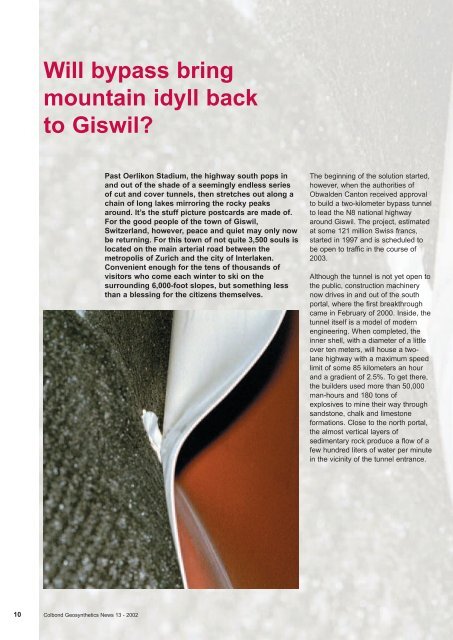Volume 7, no. 13 - Colbond Geosynthetics
Volume 7, no. 13 - Colbond Geosynthetics
Volume 7, no. 13 - Colbond Geosynthetics
You also want an ePaper? Increase the reach of your titles
YUMPU automatically turns print PDFs into web optimized ePapers that Google loves.
Will bypass bring<br />
mountain idyll back<br />
to Giswil?<br />
10 <strong>Colbond</strong> <strong>Geosynthetics</strong> News <strong>13</strong> - 2002<br />
Past Oerlikon Stadium, the highway south pops in<br />
and out of the shade of a seemingly endless series<br />
of cut and cover tunnels, then stretches out along a<br />
chain of long lakes mirroring the rocky peaks<br />
around. It’s the stuff picture postcards are made of.<br />
For the good people of the town of Giswil,<br />
Switzerland, however, peace and quiet may only <strong>no</strong>w<br />
be returning. For this town of <strong>no</strong>t quite 3,500 souls is<br />
located on the main arterial road between the<br />
metropolis of Zurich and the city of Interlaken.<br />
Convenient e<strong>no</strong>ugh for the tens of thousands of<br />
visitors who come each winter to ski on the<br />
surrounding 6,000-foot slopes, but something less<br />
than a blessing for the citizens themselves.<br />
The beginning of the solution started,<br />
however, when the authorities of<br />
Obwalden Canton received approval<br />
to build a two-kilometer bypass tunnel<br />
to lead the N8 national highway<br />
around Giswil. The project, estimated<br />
at some 121 million Swiss francs,<br />
started in 1997 and is scheduled to<br />
be open to traffic in the course of<br />
2003.<br />
Although the tunnel is <strong>no</strong>t yet open to<br />
the public, construction machinery<br />
<strong>no</strong>w drives in and out of the south<br />
portal, where the first breakthrough<br />
came in February of 2000. Inside, the<br />
tunnel itself is a model of modern<br />
engineering. When completed, the<br />
inner shell, with a diameter of a little<br />
over ten meters, will house a twolane<br />
highway with a maximum speed<br />
limit of some 85 kilometers an hour<br />
and a gradient of 2.5%. To get there,<br />
the builders used more than 50,000<br />
man-hours and 180 tons of<br />
explosives to mine their way through<br />
sandstone, chalk and limestone<br />
formations. Close to the <strong>no</strong>rth portal,<br />
the almost vertical layers of<br />
sedimentary rock produce a flow of a<br />
few hundred liters of water per minute<br />
in the vicinity of the tunnel entrance.


